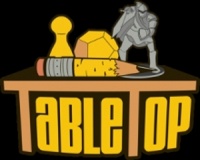
Rolling for Initiative is a weekly column by Scott Thorne, PhD, owner of Castle Perilous Games & Books in Carbondale, Illinois and instructor in marketing at Southeast Missouri State University. This week, Thorne looks at the hot new video series TableTop.
The Big Bang Party Game finally arrived, renamed and only about a year after it was originally advertised. I guess the original name, Bazinga , didn’t quite explain what people were buying and Cryptozoic figures a more straightforward The Big Bang Theory: The Party Game would better convey what customers are purchase. Hopefully, the series still has sufficient draw to generate some sales. Play is very similar to Apples to Apples. The judge selects a category card, then each player plays one or two cards they think best fit the category, with the judge deciding the winner. A twist over similar games are cards allowing players to change the category. Guess there is a lot of innuendo in the game as it is suggested for ages 15 and up.
If you are in the gaming industry and especially if you are a customer of Alliance or ACD, you have likely heard of the Web series TableTop. For those not familiar with it, TableTop is a series focusing on board, card and role-playing game, running on the Geek & Sundry channel on YouTube, hosted by actor and blogger Wil Wheaton, who also had a hand in selecting all the games featured. Each episode follows a similar format. Wheaton opens the episode by describing the game featured (usually each episode features one game, though one episode had three), then introduces the guests playing that week. Playing the game takes the bulk of each episode but since each one runs a bit less than 30 minutes, a significant amount of time reduction takes place. Brief comments by each player are interspersed throughout gameplay, then, at the end, Wheaton commiserates with the losers on the Couch of Shame and gives the winning player a trophy with their name on it. Unfortunately, as Wheaton continually points out each episode, TableTop is a low budget show so the winning player only gets the tape with their name on it, not the trophy itself. At the end, there is a brief mention of next episode’s game.
I had the opportunity to talk with Boyan Radakovich, associate producer for the show, about its genesis and the main thing about the program that concerns retailers, the link directing viewers to Amazon if they desire to purchase a copy of that episode’s game.
TableTop originated out of Google’s desire to move towards providing more professionally produced videos on YouTube, getting away from user generated and scattershot material such as "Keyboard Cat" and "Charlie Bit My Finger." While some videos racked up huge viewing numbers, millions more didn’t. Google funded the project with approximately $100 million and tapped actress, writer and producer Felicia Day to create a channel.
Day, best known for her Webseries The Guild, then contacted occasional Guild guest star and gaming aficionado Wil Wheaton to create a series for the new Geek & Sundry channel, introducing people to games he liked. Wheaton turned to Radakovich, a creative consultant for the games industry, to bring the idea to fruition. The result is TableTop.
Day, best known for her Webseries The Guild, then contacted occasional Guild guest star and gaming aficionado Wil Wheaton to create a series for the new Geek & Sundry channel, introducing people to games he liked. Wheaton turned to Radakovich, a creative consultant for the games industry, to bring the idea to fruition. The result is TableTop.
TableTop’s first season will run 20 episodes, with a new episode released every other Friday at 10 a.m. Pacific Time. With that release schedule, Radakovich expects the first season to run through early 2013. I found it interesting that the shooting schedule ran a total of 10 days with two episodes shot per day. Each episode took approximately six hours to shoot, not counting post-production, so by my count, that meant the crew put in 12 hour days during the filming of the first season. The company has already shot all of this season’s episodes, so no use contacting them to see if they will feature your game this year. A second season will depend on how successful this one turns out as YouTube will not decide until late 2012 whether to fund a second season. Success for TableTop will be determined by number of views and subscriptions to the channel. No idea what Google will consider good numbers but the Small World show, first in the series, has racked up just shy of 600,000 views.
The retailers I have talked with have overwhelmingly embraced TableTop. The only complaint is the link on each video directing the viewer either to the publisher’s homepage (in the case of Days of Wonder) or Amazon to purchase the game. Radakovich says that, after getting feedback from the gaming community, including retailers, the show will replace the links soon.
With the exception of Settlers of Catan and Munchkin (both of which are among our best sellers), all of the games featured on TableTop (save for Get Bit, out of print when I last checked) have seen a spike in sales since appearing on the show and it appears the same at a number of other retailers. Radakovich hopes that retailers will use TableTop to further grow the gaming community in their area and especially wants to make sure retailers take advantage of the two week lead time between the announcement of the next game featured and the show on which it appears (Castle Panic is next) to stock up if needed. There’s even talk of a DVD compilation available after the end of the season, which would be a great sales tool should it happen.
The opinions expressed in this column are solely those of the writer, and do not necessarily reflect the views of the editorial staff of ICv2.com.


